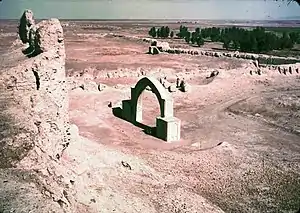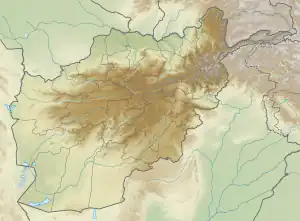Qala-e-Bost
Qala-e-Bost (Persian: قلعه بست, Pashto:بست کلا), also romanized Qalai Bust, which means the Bost Castle, is a fortress in Bost, Helmand Province, Afghanistan, built 3000 years ago.[1][2][3] It is located at 31° 30’ 02″ N, 64° 21’ 24″ E near the convergence of the Helmand and Arghandab Rivers, a half-hour's drive south of Lashkargah. Qala-e-Bost is famous for its 11th century decorative arch, which appears on the 100 Afghani note (Afghan currency). The arch is part of the remains of a mosque.[4]
Qala-e-Bost | |
|---|---|
Archeological site | |
 Ghurid dynasty arch in Qala-e-Bost | |
 Qala-e-Bost Location in Afghanistan | |
| Coordinates: 31°30′2″N 64°21′24″E | |
| Country | |
| Province | Helmand |
History
In 2006, construction began on a cobblestone road to lead from the south of Lashkargah to the Qala-e-Bost Arch (known to readers of James A. Michener's Caravans as Qala Bist.)[5] As of April 2008, it was possible to descend into an ancient shaft about 20 feet across and 200 feet deep, with a series of dark side rooms and a spiral staircase leading to the bottom. In 2020, restoration work started on the fort.[6][7]
In 2021, it became home to hundreds of people who fled Taliban clashes.[8]

See also
References
- "Helmand's Historic Bost Fort Left to Deteriorate". TOLOnews. Retrieved 2021-02-06.
- Picture of Qala-e-Bost Castle http://maiaibing.smugmug.com/Afghanistan/Helmand-Landscape-Pictures/i-vP7ch3k
- "Helmand's Archeological Glories Vanishing". RFE/RL. Retrieved 2021-02-06.
- "BOST – Encyclopaedia Iranica". iranicaonline.org. Retrieved 2021-02-06.
- National Geographic – Qala-E-Bost Arch, Afghanistan, 1968 Archived 22 August 2009 at the Wayback Machine
- "Work Begins in Helmand's Historical Sites". TOLOnews. Retrieved 2021-02-06.
- "Helmand's Bost Castle to be Restored: Officials". TOLOnews. Retrieved 2021-02-06.
- "Afghan war refugees settle in the ruins of an ancient royal city". South China Morning Post. Retrieved 2021-07-21.
